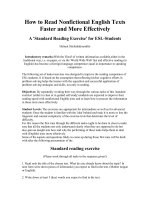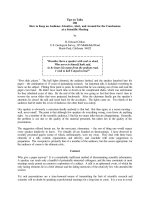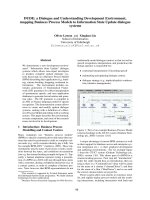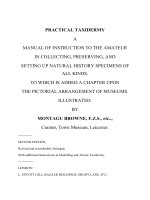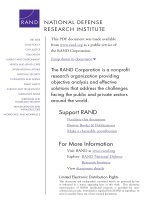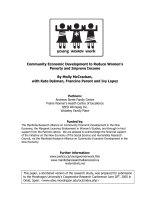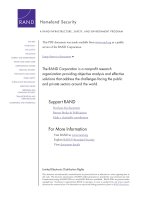Recourse to Force State Action Against Threats and Armed Attacks pptx
Bạn đang xem bản rút gọn của tài liệu. Xem và tải ngay bản đầy đủ của tài liệu tại đây (984.71 KB, 219 trang )
This page intentionally left blank
Recourse to Force
State Action Against Threats and Armed Attacks
The nations that drafted the UN Charter in 1945 clearly were more
concer
ned about peace than about justice. As a result, the Charter
prohibits all use of force by states except in the event of an armed
attack or when authorized by the Security Council.
This arrangement has only very imperfectly withstood the test
of time and changing world conditions. It did not anticipate the
Cold War which incapacitated the Security Council through the
permanent members’ frequent recourse to the veto. In requiring
states not to use force in self-defense until after they had become
the object of an actual armed attack, the Charter failed to address
a growing phenomenon of clandestine subversion and of instan-
taneous nuclear threats. Perhaps most of all, the Charter failed to
make allowance for the dramatic rise in public support for human
rights.
Fortunately, although the Charter is very hard to amend, the
drafters did agree that it should be interpreted flexibly b
y the United
Nations’ principal political institutions. In nearly sixty years, the text
has undergone extensive interpretation through this practice. In this
way the norms governing use of force in international affairs have
been adapted to meet changing circumstances and new challenges.
The book also relates these changes in law and practice to changing
public values pertaining to the balance between maintaining peace
and promoting justice.
. is Murry and Ida Becker Professor of
Law and Director, Center for International Studies at New York
University School of Law.
Available titles in the series
The Gentle Civilizer of Nations
The Rise and Fall of International Law 1870–1960
0 521 62311 1
Self-Determination of Peoples
A Legal Appraisal
0 521 63752 X
International Law and the Antarctic Treaty System
0 521 46311 4
Aspects of the Administration of International Justice
0 521 46312 2
.
State Immunity
Some Recent Developments
0 521 46319 X
-
Corporations in and under International Law
0 521 46324 6
Recourse to Force
State Action Against Threats and
Armed Attacks
THOMAS M. FRANCK
New York University School of Law
The Pitt Building, Trumpington Street, Cambridge, United Kingdom
The Edinburgh Building, Cambridge CB2 2RU, UK
40 West 20th Street, New York, NY 10011-4211, USA
477 Williamstown Road, Port Melbourne, VIC 3207, Australia
Ruiz de Alarcón 13, 28014 Madrid, Spain
Dock House, The Waterfront, Cape Town 8001, South Africa
First published in printed format
ISBN 0-521-82013-8 hardback
ISBN 0-511-03929-8 eBook
Cambrid
g
e University Press 2004
2002
(Adobe Reader)
©
Summum ius summa iniuria
“Extreme justice is injustice”
Legal maxim cited by Cicero in De Officiis I, 10, 33. The
maxim, in slightly different form, is attributed to Terence
[Publius Terentius Afer], The Self-Tormentor, 1.796 (“Ius summum
saepe summa est malitia”).
Harriette and Norman Dorsen in gratitude for a lifetime
of shared intuitions and values
Contents
Acknowledgmentspagexii
1 The United Nations’ capacity for adapting to
radicalchangesofcircumstance1
ThelegacyofSirHerschLauterpacht1
TheuseofforceundertheUNChartersystem2
Adaptability of the Charter as a quasi-constitutional
instrument5
Warinthepre-Charterera9
TheCharter’sconstraintsonviolence11
Anticipated problems in banning violence: between
thedesiderataofperpetualpeaceandperfectjustice14
Thedrafters’vision19
2UseofforcebytheUnitedNations20
TheCharterandusesofforce20
Collectiveuseofarmedforce:originalintent21
Thepractice:uncouplingArticle42fromArticle4324
TheroleoftheGeneralAssembly:originalintent31
AdaptingGeneralAssemblypowers:“UnitingforPeace”33
Inventing“Chapter61/2”39
Expanding the concept of threats to the peace, breaches
ofthepeace,andactsofaggression40
3Theoriginalparametersofself-defense45
Self-defense:thedraftinghistory45
Analyzingpracticeofcollectiveself-defense51
ix
Contents
4 Self-defense against state-sponsored terrorists
andinfiltrators53
Israel–Egypt(1956)55
OAS–DominicanRepublic(1960)56
Israel–Lebanon(1982)57
US–Nicaragua(1980–1986)60
Turkey–Iraq(1995)63
Thelawofcountermeasuresagainstterrorism64
5Self-defenseagainstideologicalsubversion69
WarsawPact–Hungary(1956)70
US–DominicanRepublic(1965)72
USSR–Czechoslovakia(1968)73
Conclusions75
6Self-defenseagainstattacksoncitizensabroad76
Belgium–TheCongo(1960,1964)78
Turkey–Cyprus(1964)79
US–DominicanRepublic(1965)81
Israel–Uganda(1976)82
US–Grenada(1983)86
US–Egypt(1985–1986)88
US–Libya(1986)89
US–Panama(1989)91
USattackonIraqiIntelligenceHeadquarters(1993)94
US–AfghanistanandSudan(1998)94
Conclusions96
7Anticipatoryself-defense97
Thetypology97
Anticipatoryuseofforceinself-defenseasalegalconcept97
Anticipatoryself-defense:post-Charterpractice99
TheCubamissilecrisis(1962–1963)99
Israeli-ArabWar(1967)101
Israel–Iraq(nuclearreactor)(1981)
105
Conclusions107
8Countermeasuresandself-help109
The“self-help”dilemma109
x
Contents
Self-help:post-Charterpractice112
Israel–Argentina(1960)112
India–Portugal(1961)114
Turkey–Cyprus(1974)117
Morocco(Mauritania)–Spain(1975)121
Indonesia–EastTimor(1975)127
Argentina–UK(Malvinas/Falklands)(1982)129
Conclusions131
9The“purelyhumanitarian”intervention135
Definition135
Humanitarianintervention:post-Charterpractice139
India–BanglaDesh(1971)139
Tanzania–Uganda(1978)143
Vietnam–Kampuchea(1978–1979)145
France–CentralAfricanEmpire(1979)151
France,UK,andUS–Iraq(theKurds,1991)152
ECOMOG–Liberia,SierraLeone(1989–1999)155
NATO–Yugoslavia(Kosovo)(1999)163
Conclusions171
10 What, eat the cabin boy? Uses of force that are
illegalbutjustifiable174
Index192
xi
Acknowledgments
This book has developed from a series of lectures given in November
2000 at Cambridge University’s Lauterpacht Research Centre for In-
ternational Law. Both that institution’s founder, Professor Sir Elihu
Lauterpacht, and its director, Professor James R. Crawford, served up
invaluable insights together with fulsome hospitality. The Centre’s fac-
ulty, fellows and students stimulated and prodded my thinking about the
role of law in a world still so far short of the goals set by Judge Sir Hersch
Lauterpacht.
I am also grateful for the continuing support of the Filomen
D’Agostino Research Fund of New York University’s School of Law,
the US Institute of Peace and for the invaluable research assistance of
John Chung, Benjamin Rosen, and Robert Dufresne.
It is difficult to account fully for the progenitors of a work that deals
with very contemporary events. Almost every conversation, these past
three years, has turned, one way or another, to this book’s subject and I
am fortunate, indeed, to have friends so richly and generously conversant
with the law and literature. They will each recognize from what I have
written, and perhaps even from what I have not written, how deeply I
value their counsel.
Once again, my deepest appreciation is reserved for my career-long
colleague Rochelle Fenchel.
xii
1
The United Nations’ capacity for
adapting to radical changes of
circumstance
The legacy of Sir Hersch Lauterpacht
When, in 1933, Judge Lauterpacht wrote The Function of Law in the In-
ternational Community, he reasoned from first principles that the world’s
legal system must be grounded in an absolute rule: “There shall be no
violence” by states. He described this as the “primordial duty of the law.”
1
At the same time, he concluded prophetically that the League of
Nations’ Covenant would fall far short of establishing that rule in
law, let alone in fact. It was full of loopholes for aggressors and their
appeasers. Loopholes drew his scorn. “It is impossible,” he observed,
“in the scheme of things devised to secure the reign of law, to provide
machinery calculated to disregard the law ”
2
Loopholes, as we shall see, are the subject of this study, which will
argue that they can be bad, but that they also have an important role to
play in saving law from itself.
After the Second World War, with Lauterpacht’s participation, the
Nuremberg tribunal was called upon to draw a much brighter line
than hitherto against aggression. So, too, at Dumbarton Oaks and San
Francisco, a UN Charter was written that makes absolute the obligation
of states not to resort to force against each other and to resist collectively
any breach of this prohibition.
New remedies, as we know from medicine, tend to produce un-
expected side effects. Article 2(4) of the Charter seemingly cures the
Covenant’s normative ambiguities regarding states’ “threat or use of
force” against each other. It plugs the loopholes. But did it intend to
1
Hersch Lauterpacht, The Function of Law in the International Community 64 (1933).
2
Lauterpacht, The Function of Law in the International Community at 372–73.
1
Recourse to Force
prevent a state – one facing imminent and overwhelming attack – from
striking first in anticipatory self-defense? Did it intend also to immu-
nize against foreign intervention a state whose government is engaged
in genocide against a part of its own population? Are there circum-
stances in which the prohibition on recourse to force in effect endorses
that which itself is wholly unconscionable? Did the Charter try to plug
too many loopholes? Has the pursuit of perfect justice unintentionally
created conditions of grave injustice?
The use of force under the UN Charter system
On its face, the UN Charter, ratified by virtually every nation, is quite
clear-eyed about its intent: to initiate a new global era in which war is
forbidden as an instrument of state policy, but collective security becomes
the norm. Collective security is to be achieved by use of international
military police forces and lesser but forceful measures such as diplomatic
and economic sanctions. Recourse to such measures is to be the exclusive
prerogative of the United Nations, acting in concert.
This new way of ensuring peace and security was to be the prescribed
cure for the disorders so evident in the first half of the twentieth century:
passivity in the face of aggression – Manchuria, Ethiopia, Czechoslo-
vakia – and the egregious pursuit through violence of narrowly perceived
national interests.
The Charter text embodies these two radical new concepts: it abso-
lutely prohibits war and prescribes collective action against those who
initiate it. We are thereby ushered into the “post-war” era through
Charter text: Articles 2(4), 42, and 43.
Article 2(4) essentially prohibits states from using force against one
another. Instead, Articles 42 and 43 envisage the collective use of force
at the behest of the Security Council upon its determination – Article
39 – that there exist what Article 2(4) forbids, a threat to the peace,
breach of the peace, or act of aggression: one that must therefore be met
by concerted police action. Article 42 sets the parameters for collective
measures, including the deployment of military forces. Under Article 43,
such forces are to be committed by member states to the service of the
Security Council.
In the idealized world of the Charter, no state would ever again attack
another: and if one did, its aggression would be met by a unified and
overwhelming response made under the authority and control of the
Security Council.
2
The United Nations’ capacity for adapting to radical changes of circumstance
Even in 1945, however, there were doubts as to whether this ideal-
ized world order was as imminent as the post-San Francisco euphoria
predicted. Thus, two articles of the Charter provide alternatives, just
in case. Article 51 authorizes states to act alone or with their allies in
self-defense against any military aggression (“armed attack”) that the
Security Council might have failed either to prevent or to repel. Article
106 makes further provision for “transitional security arrangements” by
the five permanent Council members (Britain, China, France, Russia,
and the US). These may “consult with one another” on “joint action,”
if the Security Council is disabled, “for the purpose of maintaining in-
ternational peace and security.” They are licensed to act in concert until
such time as the Council can “begin the exercise of its responsibilities.”
In this way, the Charter establishes a two-tiered system.
r
The upper tier consists of a normative structure for an ideal world –
one in which no state would initiate armed conflict, but in which any
acts of aggression that did occur would be met by effective armed
force deployed by the United Nations or, for a transitional period, by
the Security Council’s five permanent members.
r
A lower tier is to operate whenever the United Nations is unable to
respond collectively against aggression. Subject to certain conditions,
states may invoke an older legal principle: the sovereign right of self-
defense. Acting alone or with allies, the Charter authorizes members
to use force to resist any armed attack by one state on another until
UN collective measures come to the victim’s rescue. But they may do
so only after an actual armed attack.
Thus did the Charter visualize this bifurcated regime, one that pos-
tulates a common, absolute global response to aggression, but which
also makes realistic allowance for state action during the potentially pro-
longed transition from contemporary realpolitik to an ideal future of
UN-orchestrated collective security.
Both tiers, almost immediately, were seen to fail to address adequately
four seismic developments that, even as the Charter was being signed,
were beginning to transform the world.
One was the advent of the Cold War, which, because of the veto,
froze the Security Council’s ability to guarantee collective security under
Articles 42 and 43 of the Charter and precluded operation of Article 106’s
interim Big Power protectorate.
Another was the ingenuity with which states effectively and danger-
ously substituted indirect aggression – the export of insurgency and
3
Recourse to Force
covert meddling in civil wars – for the sort of traditional frontal military
aggression the Charter system was designed to prohibit by Article 2(4)
and to repress by Article 42.
The third development was the technological transformation of
weaponry (nuclear, chemical, and biological) and of delivery systems
(rocketry). These “improvements” tended to make obsolete the Charter’s
Article 51 provision for states’ “inherent” right of self-defense. In an
effort to prevent the right of self-defense being used, in Lauterpacht’s
words, “to provide machinery calculated to disregard the law in a man-
ner binding on the party which is willing to abide by the law,”
3
Article 51
limits “self-defence” to situations where an “armed attack” has occurred.
However, the acceleration and escalation of means for launching an at-
tack soon confounded the bright line drawn by the law, effecting a reductio
ad absurdum that, literally, seems to require a state to await an actual attack
on itself before instituting countermeasures. Inevitably, states responded
to the new dangers by claiming a right of “anticipatory self-defence.”
That claim, however, is not supported by the Charter’s literal text. And
“anticipatory self-defence,” too, is vulnerable to reductio ad absurdum.Ifev-
ery state were free to determine for itself when to initiate the use of force
in “anticipation” of an attack, there would be nothing left of Articles
2(4) and 51, or of Lauterpacht’s “primordial duty” to eschew violence.
The fourth development was a rising global public consciousness of
the importance of human freedom and the link between the repression
of human rights and threats to the peace. This link should have been
apparent from the history of Hitler’s rise from domestic tyrant to
global menace. But the text of the Charter puts human rights rather
at its periphery while focusing on the prevention of aggression. That
deliberate drafting choice reflected the concerns of some states that
the cause of human rights might be used to justify intervention in
their sovereign affairs. The drafters, of course, did not anticipate the
imminent end of colonialism and communism, the rise of a democratic
entitlement, and a tectonic shift in public values during the 1990s, each
of which altered perceptions of sovereignty and its limits.
All four of these developments might have been (and to some extent
were) foreseen, but the Charter’s text is not facially responsive to the
challenge of change. It, like other grand instruments written for the
long term, has had to meet the threat of obsolescence with adaption.
3
Ibid.
4
The United Nations’ capacity for adapting to radical changes of circumstance
Clark and Sohn, already in 1958, presented an elegant blueprint for
top-to-bottom overhaul.
4
Such radical revision, however, by dint of
the Charter’s Chapter XVIII, could have been accomplished only
by an unachievable agreement among the deeply divided permanent
members of the Security Council.
Nevertheless, change there has been: far more extensive and profound
than is generally acknowledged. It has come about not by the formal pro-
cess of amendment but by the practice of the United Nations’ principal
organs.
Adaptability of the Charter as a quasi-constitutional
instrument
The UN Charter is a treaty, one to which almost every state adheres.
This universality, alone, distinguishes it from the general run of interna-
tional agreements. That the drafters of the Charter recognized its special
quality is evidenced by Article 103, which purports to establish an un-
usual principle of treaty law:
In the event of a conflict between the obligations of the Members of the United
Nations under the present Charter and their obligations under any other inter-
national agreement, their obligations under the present Charter shall prevail.
This legal primacy of the Charter over subsequent agreements can
only be construed as a “quasi-constitutional” feature. Clearly, it illus-
trates that the drafters intended to create a special treaty different from
all others.
5
This difference becomes relevant when we consider the in-
strument’s capacity for adaption through the interpretative practice of
its organs and members.
There were spirited debates at San Francisco in 1945 about the
process by which the Charter would be interpreted. Some states argued
that this ought to be the exclusive prerogative of the Organization’s
judiciary, the International Court of Justice (ICJ). Others preferred to
leave each political organ free to interpret its own sphere of authority.
In the event, the Charter was framed so as to allow for interpretation
both by the political and the judicial organs.
4
Granville Clark and Louis B. Sohn, World Peace Through World Law (1958).
5
See Articles 58, 59 Vienna Convention on the Law of Treaties, May 23, 1969, 1152
U.N.T.S. 331 (1969); 8 I.L.M. 679 (1969). Entered into force 27 January 1980.
5
Recourse to Force
But it is the political organs that have done most of this interpretative
work, especially but not solely with respect to the fraught boundary
between the United Nations’ jurisdiction and the jealously guarded
sovereignty of its members. In the words of Professor, now Judge,
Rosalyn Higgins: it “is significant that at the San Francisco Confer-
ence the proposal to confer the point of preliminary determination [of
jurisdiction] upon the International Court of Justice was rejected.”
6
For
example, two key questions regarding the interpretation of the Charter’s
important Article 2(7) – whether a matter is beyond the United Nations’
jurisdiction because it is “essentially within the domestic jurisdiction”
of states and whether, consequently, the United Nations is barred
from taking a proposed action because to do so would violate the
requirement not to “intervene” in such matters – usually are decided
by the political organ in the course of dealing with a crisis. “[S]uffice it
to say,” Higgins has concluded, “that the political organs of the United
Nations have clearly regarded themselves entitled to determine their
own competence.”
7
Moreover, these interpretations of the Charter
are made in the relevant political organ not by a formal vote but as a
merged, or even submerged, part of its “decisions on the matter at issue,
and often by implication.”
8
While, under Article 96 of the Charter,
the International Court may be asked to render an advisory opinion,
Higgins stressed, judicial “consultation is not obligatory”
9
and resort to
it has been infrequent, although not without significance.
What emerges from the vast legacy of recorded debates and decisions
of the principal political organs is that they tend to treat the Charter not
as a static formula, but as a constitutive instrument capable of organic
growth. Borrowing a phrase coined by the Imperial Privy Council
speaking of the Canadian constitution, the Charter is “a living tree.”
10
Ordinary treaties are not “living trees” but international contracts
to be construed in strict accord with the black-letter text. Not so
the Charter. The Charter also differs from most treaties not only in
6
Rosalyn Higgins, The Development of International Law Through the Political Organs of the
United Nations 66 (1963) and n. 27, discussing the failure of a Greek proposal to give
sole kompetenz-kompetenz which secured 14–17 support, but not the necessary two-thirds
majority needed to amend the draft.
7
Higgins, The Development of International Law Through the Political Organs of the United Nations
at 66–67.
8
Ibid.
9
Higgins, The Development of International Law Through the Political Organs of the United Nations
at 67 and n. 34.
10
Edwards v. A.G. Canada [1930] A.C. 124 at 136 (P.C.).
6
The United Nations’ capacity for adapting to radical changes of circumstance
enumerating rights and duties but also in elaborating institutions to
carry them into effect. Two political organs (the General Assembly and
the Security Council) were given Charter-implementing powers: Chap-
ters IV and V, respectively. An independent civil service, the Secretariat,
headed by a Secretary-General, enjoys autonomous, Charter-based
power to construe and apply the Charter and decisions of the political
organs.
11
Although the International Court is authorized to interpret
the Charter in adversarial proceedings between states or at the request
of the principal political organs,
12
the extent to which the Charter
establishes political and executory machinery for implementing its
purposes, principles and norms distinguishes it from ordinary treaties
and invests it with a potential for adaption through organic practice. In
this, it is both unusual and quasi-constitutional.
Further, the Charter makes allowance for its interpretation through
state practice. It reserves an ample sphere of autonomy for member
states by giving each an equal vote in the General Assembly while
guaranteeing members’ “sovereign equality,”
13
prohibiting the United
Nations from intervening “in matters which are essentially within
the domestic jurisdiction of any state” (subject to one exception),
14
and preserving each state’s “inherent right of individual or collective
self-defence if an armed attack occurs ”
15
Taken together, these
provisions ensure that the Charter will be subjected to continuous
interpretation and adaption through the member states’ individual and
collective practice: their actions, voting, and rhetoric.
Each principal organ and the members thus continuously interpret the
Charter and do so in accordance with the requisites of ever-changing
circumstances. This necessarily means that the Charter text is always
evolving. One important example pertains to Article 27(3), which con-
tains the key “veto power.” It provides:
Decisions of the Security Council
on all [non-procedural] matters shall be made
by an affirmative vote of nine members including the concurring votes of the
permanent members
In practice, for many years, each President of the Security Council
(the post rotates monthly among Council members) has interpreted
this provision to mean that an abstention by a permanent member is
not counted as a veto. A strict-constructionist reading of Article 27(3)
11
UN Charter, Articles 97–101.
12
UN Charter, Chapter XIV.
13
UN Charter, Article 18 and Article 2(1), respectively.
14
UN Charter, Article 2(7).
15
UN Charter, Article 51.
7
Recourse to Force
might have predicted otherwise. Still, in 319 instances,
16
very important
decisions have been made in the face of – and without objection
from – abstaining permanent members. It may be concluded that
the treaty text of Article 27(3) now conveniently permits a permanent
member to register discomfort with a proposed course of action by
abstaining on a resolution authorizing it, while still permitting the
resolution to pass and, by virtue of Article 25, to become binding on
all members. The Court has given this interpretation-in-practice its
blessing. In the 1971 Namibian advisory opinion, it found “abundant
evidence” of members’ acceptance of the principle that a voluntary
abstention by a permanent member does not constitute a veto.
17
The
16
While it is not always clear whether a Security Council Resolution decides a procedu-
ral matter for the purposes of article 27(2) of the UN Charter, it can be approximated
that, as of 2001, the Security Council had adopted 319 resolutions on non-procedural
matters in which at least one permanent member either abstained or did not partici-
pate in the vote. These resolutions include the following: S/RES/4 (1946); S/RES/17,
18, 19, 22, 23, 28, 30, 31, 32, 35, 36 (1947); S/RES/38, 39, 40, 41, 42, 46, 48, 49,
51, 52, 53, 54, 55, 61, 63, 64, 65, 66 (1948); S/RES/68, 69, 70, 71, 73, 74, 75, 76,
77, 78 (1949); S/RES/79, 80, 81, 82, 83, 84, 85, 86, 89 (1950); S/RES/91, 92, 93,
95, 96 (1951); S/RES/98 (1952); S/RES/101, 102, 103 (1953); S/RES/109, 110
(1955); S/RES/122, 123, 126 (1957); S/RES/128, 131, 134, 135, 138, 143, 146,
156, 157 (1960); S/RES/161, 162, 163, 164, 166, 167, 169 (1961); S/RES/171, 176
(1962); S/RES/179, 180, 181, 183 (1963); S/RES/188, 190, 191, 193, 199 (1964);
S/RES/202, 205, 215, 216, 217, 218 (1965); S/RES/221, 232 (1966); S/RES/252,
255, 259 (1968); S/RES/264, 265, 268, 269, 271, 273, 275 (1969); S/RES/276, 280,
282, 283, 284, 285, 290 (1970); S/RES/294, 301, 302, 305, 307 (1971); S/RES/309,
310, 311, 312, 314, 315, 316, 317, 318, 319, 320, 321, 323, 324 (1972); S/RES/326,
327, 328, 330, 332, 333, 334, 338, 339 340, 341, 343, 344 (1973); S/RES/346, 347,
348, 349, 350, 355, 359, 360, 362, 363, 364 (1974); S/RES/368, 369, 370, 371, 376,
378, 381, 383 (1975); S/RES/387, 389, 390, 391, 393, 396, 397, 398, 401 (1976);
S/RES/403, 408, 410, 415, 416, 420, 422 (1977); S/RES/423, 425, 426, 427, 429,
430, 431, 434, 435, 437, 438, 439, 441, 443 (1978); S/RES/444, 445, 446, 447, 448,
449, 450, 451, 452, 454, 456, 458, 459, 460, 461 (1979); S/RES/463, 467, 468, 469,
470, 471, 472, 474, 475, 476, 478, 481, 482, 483 (1980); S/RES/485, 486, 488, 493,
498 (1981); S/RES/501, 502, 511, 515, 517, 519, 523 (1982); S/RES/529, 536, 538,
539, 545 (1983); S/RES/546, 549, 550, 554, 555, 556 (1984); S/RES/561, 566, 569,
573, 575 (1985); S/RES/581, 587, 592 (1986); S/RES/601, 605 (1987); S/RES/608,
611, 623 (1988); S/RES/636, 641 (1989); S/RES/678 (1990); S/RES/686, 688
(1991); S/RES/748, 757, 770, 776, 777, 778, 781, 787, 792 (1992); S/RES/816,
820, 821, 825, 855, 883 (1993); S/RES/929, 940, 942, 944 946, 955, 964 (1994);
S/RES/970, 975, 988, 998, 1003, 1021 (1995); S/RES/1054, 1058, 1067, 1070,
1073, 1077, 1082 (1996); S/RES/1101, 1114, 1129, 1134 (1997); S/RES/1160,
1180, 1199, 1203, 1207, 1212 (1998); S/RES/1239, 1244, 1249, 1277, 1280 (1999);
S/RES/1290, 1305, 1322 (2000).
17
Legal Consequences for States of the Continuing Presence of South Africa in Namibia (South West
Africa) notwithstanding Security Council Resolution 276 (1970), Advisory Opinion, [1971] I.C.J.
Rep. 16 at 22, para. 22.
8
The United Nations’ capacity for adapting to radical changes of circumstance
long-term implications of that adaption have been immense. For exam-
ple, the Council was able to authorize Operation Desert Storm against
Iraq in November 1990 despite the abstention of China.
18
So, too, the
1999 resolution establishing the interim international administration
for Kosovo was adopted by the Council despite China’s abstention.
19
There are many other instances of such adaption, effected by the
practice of the principal organs. We shall be examining this practice
insofar as it pertains to the use of force. What such an examination will
demonstrate, aside from substantive changes in an applicable norm, is
the system’s capacity for change.
Of course, one must be parsimonious in advancing this thesis, lest, as
Lauterpacht warned, the line between violation and adaption becomes
hopelessly blurred. Nevertheless, the Charter cannot today be under-
stood without regard for these changes. In particular, we will examine
the effect of Charter adaption in two respects not contemplated by its
authors:
1. Where collective force has been deployed or authorized by the United Nations
itself to confront a threat to the peace or breach of the peace that has arisen not
solely out of state-to-state aggression but, also, from events occurring solely
or primarily within one state.
2. Where force has been deployed autonomously by states claiming to act in
individual or collective self-defense not against an actual military attack by an
aggressor state but either in anticipation of such an attack or in response to
indirect aggression such as the harbouring of insurgents or terrorists; or in
response to an act by a terrorist group that is not a state; or in an assertion of
a right of self-help to end persistent and egregious violations of international
law and human rights.
Before addressing in detail the Charter adaptions that may have oc-
curred through institutional or state action, it is useful to consider the
historical context of the salient Charter provisions and how they came
to be shaped in the inceptive period, 1943–45.
War in the pre-Charter era
The League Covenant and the UN Charter together mark a rad-
ical departure in systemic response to violence among states. The
Lauterpachtian first law of an international order – “there shall be no
18
S/RES 678, of 29 November 1990.
19
S/RES 1244, of 10 June 1999.
9
Recourse to Force
violence” – is a radical innovation in a legal system which had hitherto
been careful to distinguish between legally permissible and impermissi-
ble wars and permissible and impermissible modes of conducting war.
20
Neither the jus ad bellum nor the jus in bello regarded recourse to violence as
a wrong per se. Oppenheim, writing in 1906, castigated naive “fanatics of
international peace” who “frequently consider war and law inconsistent
Itisnot difficult,” he said, “to show the absurdity of this opinion.”
21
A dozen years later, viewed across the killing-grounds of the First World
War, the “opinion” began to seem less “absurd.” The first indications
of the very modern idea that the use of force by a state against another
could itself be violative of the legal order’s very foundations is found in
the Covenant of the League of Nations, which set forth some elementary
provisions intended to limit the right of states to make war, and sought
to impose a mandatory “cooling off period” on disputants.
22
While the
Covenant did not precisely prohibit war, it did oblige states not to resort
to force as long as a dispute was under consideration by the League’s
Council. However, once this process failed to produce a settlement the
disputants remained free “to take such action as they shall consider
necessary for the maintenance of right and justice.”
23
The Covenant also empowered the League Council to impose collec-
tive sanctions on states resorting to war in violation of its stated require-
ment to seek peaceful settlement
24
and obliged states to act individually
or collectively through the Council to defend victims of aggression.
25
Thus, for the first time, the Lauterpachtian injunction – “there shall be
no violence” – is both stated and given rudimentary tools of enforcement.
Nevertheless, these injunctions were directed (in Articles 12 and 16) only
against states’ “resort to war” – a very narrow term of the draftsman’s
art invoking a formal declaration – even though earlier drafts of the
Covenant had proposed a much wider ban on “resort to armed force.”
26
In the inter-war period, a series of multilateral treaties attempted
to reinforce the new rule against war-making. In Article 2 of the
Locarno Treaty, Germany, Belgium, and France undertook “in no
case [to] attack or invade each other or to resort to war” and, more
20
A history of these distinctions is found in Thomas M. Franck, Fairness in International
Law and Institutions 245–83 (1995).
21
Lassa Oppenheim, II International Law 55 (1906).
22
F.S. Northedge, The League of Nations 2 (1986).
23
League of Nations, Covenant, Article 15(7).
24
League of Nations, Covenant, Article 16.
25
League of Nations, Covenant, Article 10.
26
Ian Brownlie, International Law and the Use of Force by States 60 (1963).
10
The United Nations’ capacity for adapting to radical changes of circumstance
significantly, these nations, together with Britain and Italy, each under-
took “immediately to come to the help” of a “Party against whom a
violation or breach has been directed as soon as [the guarantor] has been
able to satisfy itself that this violation constitutes an unprovoked act of
aggression ”
27
Adherence to the pact was terminated by Germany,
however, in 1936.
Broader in membership and more durable was the 1928 Pact of Paris,
the Kellogg–Briand Pact for the Renunciation of War,
28
which, by 1938,
had sixty-three state parties.
29
They were committed, by Article 2, to
the rule “that the settlement or solution of all disputes or conflicts of
whatever nature or whatever origin they may be, which may arise among
[the Parties] shall never be sought except by pacific means.” Its preamble
proclaims an outright renunciation of war as an instrument of policy.
This inter-war system, as we know to our cost, collapsed under the
weight of Japan’s invasion of Manchuria in 1931, Italy’s conquest of
Ethiopia in 1936, and Russia’s attack on Finland in 1939. At the time
of the bombardment of Pearl Harbor, Japan was still a party to the
Kellogg Pact. Inevitably, this failed attempt at behavior-modification in-
vited skepticism. Professor Arthur Nussbaum, in 1947, wrote that “even
sober observers” had believed that they had seen “inaugurated a new
era of international law, but history has not justified that belief.”
30
Whether, thereafter, the Covenant’s successor, the UN Charter, has
actually succeeded in inaugurating a new era remains to be seen; but its
text, and the negotiations leading to its adoption at San Francisco, leave
little doubt that this was the solemn intent of its framers.
The Charter’s constraints on violence
The Charter’s absolute prohibition on states’ unilateral recourse to force,
Article 2(4), is deliberately located in Chapter I, entitled “Purposes and
Principles.” The drafters considered these enumerated principles of tran-
scendent importance, elucidating all other provisions of the Charter and
indicating “the direction which the activities of the Organization are to
take and the common ends of its members.”
31
27
Treaty of Mutual Guarantee, done at Locarno, October 16, 1925, 54 L.N.T.S. 290,
article 2, 4(3).
28
94 L.N.T.S. 57.
29
33 Am. J. Int’l L. Supp. 865 (1939).
30
Arthur Nussbaum, A Concise History of the Law of Nations 251 (1947).
31
Leland Goodrich and Edvard Hambro, Charter of the United Nations: Commentary and
Documents 22 (2nd edn., 1949).
11
